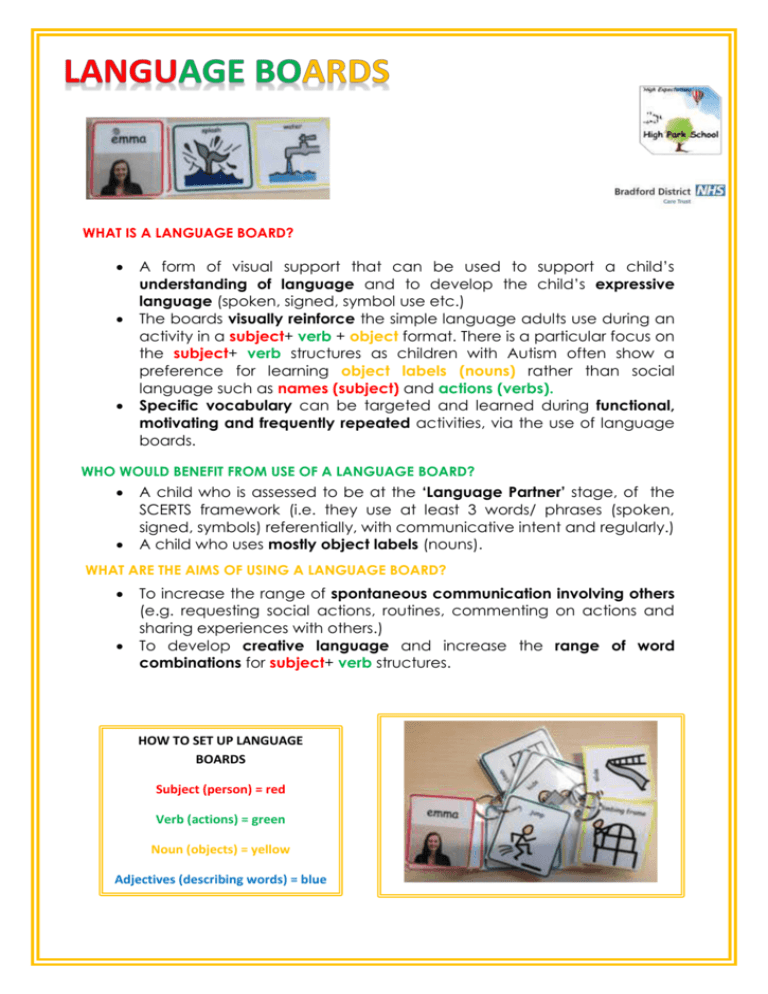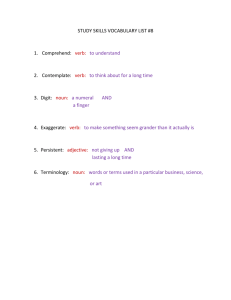Language Board factsheet
advertisement

WHAT IS A LANGUAGE BOARD? A form of visual support that can be used to support a child’s understanding of language and to develop the child’s expressive language (spoken, signed, symbol use etc.) The boards visually reinforce the simple language adults use during an activity in a subject+ verb + object format. There is a particular focus on the subject+ verb structures as children with Autism often show a preference for learning object labels (nouns) rather than social language such as names (subject) and actions (verbs). Specific vocabulary can be targeted and learned during functional, motivating and frequently repeated activities, via the use of language boards. WHO WOULD BENEFIT FROM USE OF A LANGUAGE BOARD? A child who is assessed to be at the ‘Language Partner’ stage, of the SCERTS framework (i.e. they use at least 3 words/ phrases (spoken, signed, symbols) referentially, with communicative intent and regularly.) A child who uses mostly object labels (nouns). WHAT ARE THE AIMS OF USING A LANGUAGE BOARD? To increase the range of spontaneous communication involving others (e.g. requesting social actions, routines, commenting on actions and sharing experiences with others.) To develop creative language and increase the range of word combinations for subject+ verb structures. HOW TO SET UP LANGUAGE BOARDS Subject (person) = red Verb (actions) = green Noun (objects) = yellow Adjectives (describing words) = blue HOW TO USE A LANGUAGE BOARD Supporting the child’s understanding of language: The adult watches what the child does within an activity and makes comments using simple phrases (either subject+ verb or subject + verb + object structures) both verbally and visually. The adult selects the relevant subject, verb and object symbols (according to what the child is doing within an activity) and adds to the board. The adult attracts the child’s attention to the board by pointing to each symbol and saying each symbol verbally (e.g. ‘Emma pour water’.) The adult repeats/ modifies the phrase throughout the activity/ interaction. The adult remembers to use the language boards as naturally and positively as possible. Communication should be fun! Supporting the child’s expressive language: Language boards can also be used to extend what a child already communicates to us through words/ symbols. If the child makes a comment/ request using a single noun (e.g. ‘Ipad’) we can create a language board to extend their request further (e.g. ‘Emma give Ipad’.) It is good practice to model the request initially ourselves as above. As the child makes repeated requests to us, we can insert pauses whilst pointing to the relevant symbols to encourage the child to ‘fill in the gap’. We may then encourage the child to extend and build upon their request on the board by offering choices for the child to choose from. Initially, the child will select the noun and add to a language board with the subject + verb already attached by the adult. Over time, the child will move onto selecting the correct adult to direct the request to (i.e. the adult who has what they want / need) and the correct verb. We then encourage the child to verbalise their request by pointing to each symbol and waiting for them to identify it. If they do not, we just fill the gap ourselves as a model and move onto the next one. We then respond to the request as quickly as possible so as to show that communication is worth the effort and is rewarding.








